theartsdesk in Johannesburg: Black Diamonds at the Wits Museum | reviews, news & interviews
theartsdesk in Johannesburg: Black Diamonds at the Wits Museum
theartsdesk in Johannesburg: Black Diamonds at the Wits Museum
The opening of a ground-breaking new museum raises some pressing questions about modern South Africa
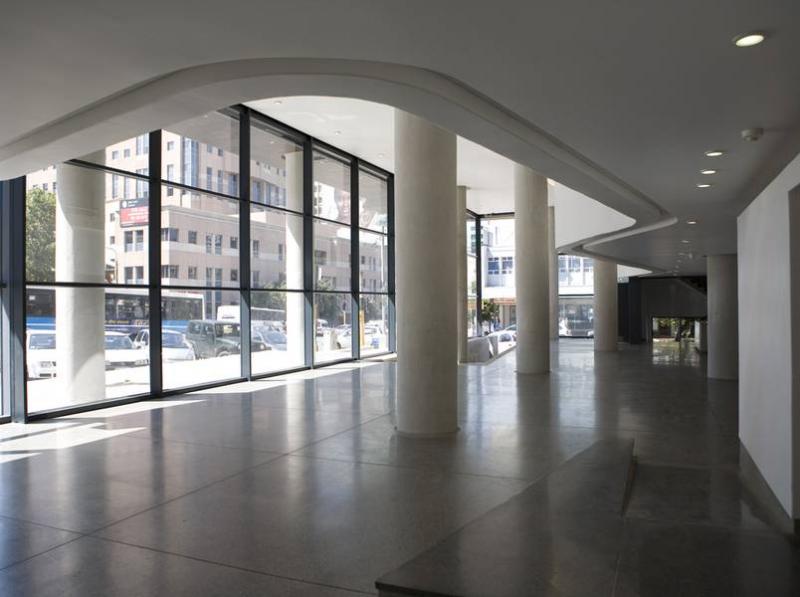
The new Wits Museum in Johannesburg is located in an old Shell petrol station and stands on the corner behind a vast glass frontage. The winner of the 2012 VISI architecture award, it is big, akin to the Guggenheim in its sense of architectural swagger, and aglow with beckoning wonders. And, at noon on a Saturday, it is empty.
Inside this building, attached to the Witwatersrand University, is one of the most eclectic, intellectually brave, diverse, challenging and political displays of art, photography, sculpture, religious icons, masks, baskets and weaving that Africa can muster. It rivals anything New York, Europe or Asia can offer. So where are the crowds?
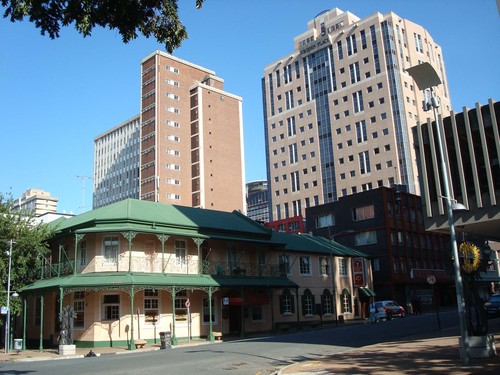 Julia Charlton is the co-curator of the exhibition, which houses 60 years of collections from academics and businesswomen, including Anitra Nettleton, Gertrude Possel and Professor Heather Martienssen. She says, "This is a generation thing, not a colour thing. Art at the moment is all about status, so if people go to galleries, or collect art, they want stuff that says, I didn’t struggle to be POOR." She continues, “Visual literacy is very nascent in this country, we are still learning what an incredible range our artists have produced, from four metre high intricately woven baskets to the iconic work of Sam Nhlengethwa, whose collage It Left Him Cold (The Death of Steve Biko), 1990, refers to the murder in detention of the black consciousness leader. This collection has taken 10 years to come to fruition, and at one level it just needs a public.”
Julia Charlton is the co-curator of the exhibition, which houses 60 years of collections from academics and businesswomen, including Anitra Nettleton, Gertrude Possel and Professor Heather Martienssen. She says, "This is a generation thing, not a colour thing. Art at the moment is all about status, so if people go to galleries, or collect art, they want stuff that says, I didn’t struggle to be POOR." She continues, “Visual literacy is very nascent in this country, we are still learning what an incredible range our artists have produced, from four metre high intricately woven baskets to the iconic work of Sam Nhlengethwa, whose collage It Left Him Cold (The Death of Steve Biko), 1990, refers to the murder in detention of the black consciousness leader. This collection has taken 10 years to come to fruition, and at one level it just needs a public.”
South Africa is confusing and full of contradictions these days. The former no-go Braamfontein area (pictured above right) in Jo’burg’s commercial and business district has been revived. What was once a multi-storey car park is now an organic Sunday food market hangout, surrounded by small art galleries. Young, trendy, black 20-somethings, sporting pointless square specs, low slung jeans and complex haircuts, like their brothers and sisters in Hoxton, Manchester and Paris, sip cappuccinos. The headscarf - or "dook" - worn by (black) cleaning ladies, once a mark of oppression, is now a fashion item for these young hipsters. Clever cartoonists (notably the chattering classes’ favourite Zapiro) are having a field day: polemic, critique, criticism, is out in the open.
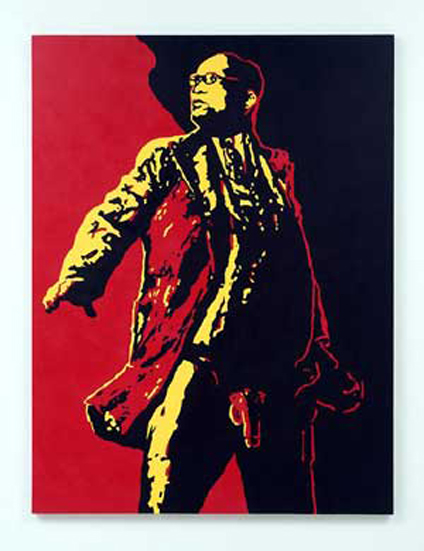 One particular cartoon is doing the rounds and dominating the headlines, of President Jacob Zuma and various references to his "spear". It is referring to an art work (pictured left) by a young artist, Brett Murray, that has resulted in death threats to the artist. One of the most vigorous threats came from a church congregation. In the painting, Zuma is shown naked, with a circumcised penis. In an extraordinary turnabout, normally "liberal" critics have rushed to defend Zuma and criticise the work, citing the offensiveness of the image. Zuma’s lawyer broke down in tears in a televised news piece, causing the liberal (white) art establishment to seriously question itself. As Julia Charlton remarks, “for those of us in the art world, a penis is no big deal, but it was humbling to see a grown man cry in public.” Clearly the painting hints at much larger humiliations inflicted on black African men over hundreds of years.
One particular cartoon is doing the rounds and dominating the headlines, of President Jacob Zuma and various references to his "spear". It is referring to an art work (pictured left) by a young artist, Brett Murray, that has resulted in death threats to the artist. One of the most vigorous threats came from a church congregation. In the painting, Zuma is shown naked, with a circumcised penis. In an extraordinary turnabout, normally "liberal" critics have rushed to defend Zuma and criticise the work, citing the offensiveness of the image. Zuma’s lawyer broke down in tears in a televised news piece, causing the liberal (white) art establishment to seriously question itself. As Julia Charlton remarks, “for those of us in the art world, a penis is no big deal, but it was humbling to see a grown man cry in public.” Clearly the painting hints at much larger humiliations inflicted on black African men over hundreds of years.
Is the public anger simply Zulu machismo in another guise, or indignant humiliation at this racist stab at Zuma’s manhood? As Carolyn Dempster, owner of Rwhavi Fine Art and Sculpture says, “From the Sixties to the Eighties arts in all its forms, from satire to cartoons to photographs, had a clear focus, which wasn’t necessarily expressed in a direct way, because of the legislation. Art was an expression of the political struggle, it was a way to tell stories that weren’t being told. Now, in democracy, we are struggling to find our individual voices, and not just being defined by the political. This takes a while to emerge.”
Paul Stopforth, a lecturer in fine art at Wits, in the Eighties confronted the torture and death in detention that was taking place under the apartheid government. Some seminal works in the collection reflect the University’s stance in opposing apartheid. Biko I and Biko II are drawn from post-mortem photographs taken by the pathologists at Biko’s autopsy, which Stopforth accessed through a lawyer representing his family. “I think it’s important we don’t forget the awful brutality of these times, and how unbelievably risky and dangerous it was to produce art like this at the time," says Charlton. Against the backdrop of obvious materialism of the "New South Africa" (which has just recently lost its status as a developing country in the eyes of the UN) young black professionals vie to fill their fridges with the latest European Chablis. At least so says Jo’burg arts writer Lerato Mogathle, who believes that South Africa is losing its integrity, ethics and aesthetical rigour, partly because there is no historical grounding in the arts.
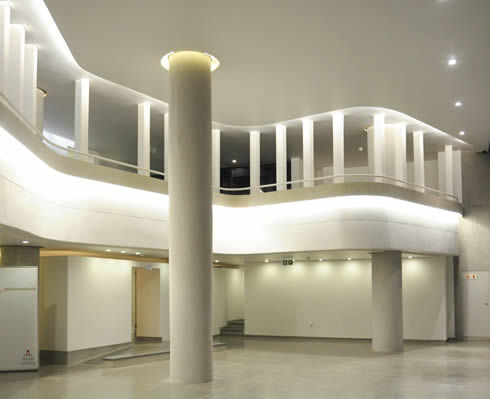 In the Wits - which deliberately opted to be a Museum rather than a gallery - the push to get black artists and political art into the mainstream is clear. The classics of apartheid art, such as the watercolourist Gerard Sekoto (promoted by Johannesburg newspaper The Sowetan in 1989, who repatriated his work from Paris), and the Picasso-esque Sydney Khumalo – who trained at apartheid’s only concession to artists, the Polly Studios – are showcased. The Homelands series by international photographer David Goldblatt is displayed next to a massive 10 metre length of kente cloth, and baskets intricately woven from multi-coloured telephone wire. This is a deliberate attempt both to explore artistic normsand to question the difference between representational and functional art. Typically, in apartheid South Africa, ethnic equalled craft and was demeaned in the process.
In the Wits - which deliberately opted to be a Museum rather than a gallery - the push to get black artists and political art into the mainstream is clear. The classics of apartheid art, such as the watercolourist Gerard Sekoto (promoted by Johannesburg newspaper The Sowetan in 1989, who repatriated his work from Paris), and the Picasso-esque Sydney Khumalo – who trained at apartheid’s only concession to artists, the Polly Studios – are showcased. The Homelands series by international photographer David Goldblatt is displayed next to a massive 10 metre length of kente cloth, and baskets intricately woven from multi-coloured telephone wire. This is a deliberate attempt both to explore artistic normsand to question the difference between representational and functional art. Typically, in apartheid South Africa, ethnic equalled craft and was demeaned in the process.
In the face of these challenges the growth in art collecting is obvious. Says Carolyn Dempster, who supplies the upper end of the Southern African market with large, bespoke Zimbabwean stone sculpture, “We have a breed of get-rich-quick entrepreneurs who want to show off their money, their status, their power. One, Kenny Kunene, recently held an event where people ate sushi off a naked woman. She was white. Most of the invited were black. It was a clear statement: people like him will collect corporate art as an investment, not interesting, challenging art. We’re still very conservative in our understanding of art.”
According to Lerato Moghatle, materialism has become the new equality, and "black diamonds" (aspirant black professionals) only use art to establish their buying power, not their taste. Julia Charlton concurs: “Art is not on the curriculum in the South African state education sector, unbelievably. Community arts projects aren't adequately funded, and most poorer families do not grow up with what is regarded as standard in British homes: pens, paper and paintbrushes." As for the market, although corporate capitalist expansion is very much alive and thrashing in South Africa, and they buy art for their offices, they take the safe narrow options and thus don’t encourage new, experimental artists.
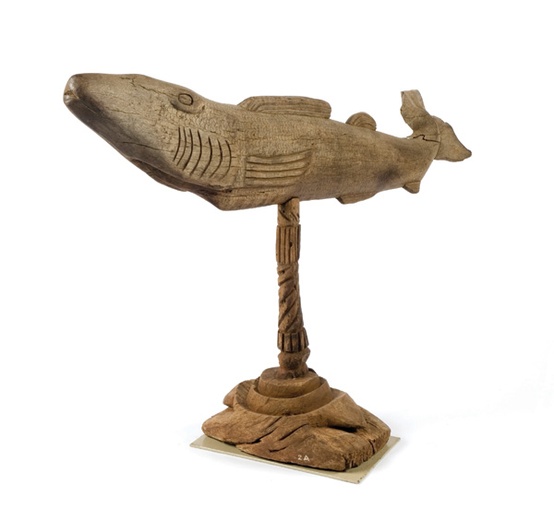 In Durban the BAT Community Arts Centre is a place where experimentation is actively encouraged. There are over 60 litho-printmakers, etchers and painters who work together in an old converted warehouse on the docks. One of these printmakers is Malibongwe Shangase. He is 27, has been painting and drawing since he was four, and received no formal art training. He paints and prints 60 hours a week, managing to make a living from the abstract prints of animals that he sells from his open, communal studio. Describing his conceptual prints, he says “I am lucky because my art comes to me in visions, in dreams, so this is where I get my inspiration, and I am driven to paint, to create. But I think I am unusual. We had no drawing stuff or artists in our family, but I was driven, almost obsessed.”
In Durban the BAT Community Arts Centre is a place where experimentation is actively encouraged. There are over 60 litho-printmakers, etchers and painters who work together in an old converted warehouse on the docks. One of these printmakers is Malibongwe Shangase. He is 27, has been painting and drawing since he was four, and received no formal art training. He paints and prints 60 hours a week, managing to make a living from the abstract prints of animals that he sells from his open, communal studio. Describing his conceptual prints, he says “I am lucky because my art comes to me in visions, in dreams, so this is where I get my inspiration, and I am driven to paint, to create. But I think I am unusual. We had no drawing stuff or artists in our family, but I was driven, almost obsessed.”
The route into art via religion is very common in Southern Africa. One of the most famous proponents in this "prophet/artist" mould is Jackson Hlungwani, a completely untrained man who, with his sons, began carving eight foot wood characters from the bible which stood in his garden. These attracted audiences, to whom he preached, performed healing rites and ran bible classes. The Altar of God is a depiction of the disciples (pictured above left, Jonah's Fish, from the Altar of God series), and is part of an extensive shrine called The New Jerusalem created in the late 1970s to mid-1980s. Before it was moved to the Wits Museum it stood outside, miles from any large town, in his rural village in Mbokhoto, near Elim in Limpopo Province.
By the door, the young attendant concedes she’d choose a mall to spend her time, not a museum, but she needs the money. She adds that they’ve had to remove all the collection boxes, and the nearby Johannesburg Gallery, in Joubert Park, has been burgled - again. She smiles when I ask her why the gallery is empty. “I dunno, maybe my generation has just got too much choice. We’re enjoying being part of the world again, we need to give it time! The spear cartoon has really got us going though, so art is very important.”
Explore topics
Share this article
The future of Arts Journalism
You can stop theartsdesk.com closing!
We urgently need financing to survive. Our fundraising drive has thus far raised £49,000 but we need to reach £100,000 or we will be forced to close. Please contribute here: https://gofund.me/c3f6033d
And if you can forward this information to anyone who might assist, we’d be grateful.

Subscribe to theartsdesk.com
Thank you for continuing to read our work on theartsdesk.com. For unlimited access to every article in its entirety, including our archive of more than 15,000 pieces, we're asking for £5 per month or £40 per year. We feel it's a very good deal, and hope you do too.
To take a subscription now simply click here.
And if you're looking for that extra gift for a friend or family member, why not treat them to a theartsdesk.com gift subscription?
more Visual arts
 'We are bowled over!' Thank you for your messages of love and support
Much-appreciated words of commendation from readers and the cultural community
'We are bowled over!' Thank you for your messages of love and support
Much-appreciated words of commendation from readers and the cultural community
 Folkestone Triennial 2025 - landscape, seascape, art lovers' escape
Locally rooted festival brings home many but not all global concerns
Folkestone Triennial 2025 - landscape, seascape, art lovers' escape
Locally rooted festival brings home many but not all global concerns
 Sir Brian Clarke (1953-2025) - a personal tribute
Remembering an artist with a gift for the transcendent
Sir Brian Clarke (1953-2025) - a personal tribute
Remembering an artist with a gift for the transcendent
 Emily Kam Kngwarray, Tate Modern review - glimpses of another world
Pictures that are an affirmation of belonging
Emily Kam Kngwarray, Tate Modern review - glimpses of another world
Pictures that are an affirmation of belonging
 Kiefer / Van Gogh, Royal Academy review - a pairing of opposites
Small scale intensity meets large scale melodrama
Kiefer / Van Gogh, Royal Academy review - a pairing of opposites
Small scale intensity meets large scale melodrama
 Jenny Saville: The Anatomy of Painting, National Portrait Gallery review - a protégé losing her way
A brilliant painter in search of a worthwhile subject
Jenny Saville: The Anatomy of Painting, National Portrait Gallery review - a protégé losing her way
A brilliant painter in search of a worthwhile subject
 Abstract Erotic, Courtauld Gallery review - sculpture that is sensuous, funny and subversive
Testing the boundaries of good taste, and winning
Abstract Erotic, Courtauld Gallery review - sculpture that is sensuous, funny and subversive
Testing the boundaries of good taste, and winning
 Edward Burra, Tate Britain review - watercolour made mainstream
Social satire with a nasty bite
Edward Burra, Tate Britain review - watercolour made mainstream
Social satire with a nasty bite
 Ithell Colquhoun, Tate Britain review - revelations of a weird and wonderful world
Emanations from the unconscious
Ithell Colquhoun, Tate Britain review - revelations of a weird and wonderful world
Emanations from the unconscious
 Rachel Jones: Gated Canyons, Dulwich Picture Gallery review - teeth with a real bite
Mouths have never looked so good
Rachel Jones: Gated Canyons, Dulwich Picture Gallery review - teeth with a real bite
Mouths have never looked so good
 Yoshitomo Nara, Hayward Gallery review - sickeningly cute kids
How to make millions out of kitsch
Yoshitomo Nara, Hayward Gallery review - sickeningly cute kids
How to make millions out of kitsch
 Hamad Butt: Apprehensions, Whitechapel Gallery review - cool, calm and potentially lethal
The YBA who didn’t have time to become a household name
Hamad Butt: Apprehensions, Whitechapel Gallery review - cool, calm and potentially lethal
The YBA who didn’t have time to become a household name

Add comment